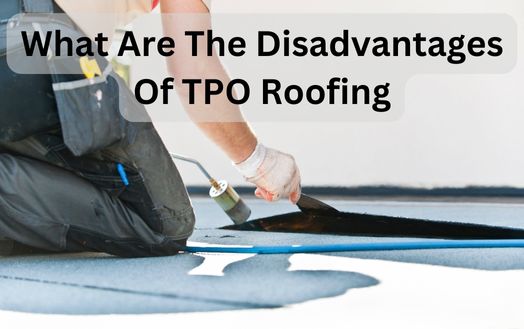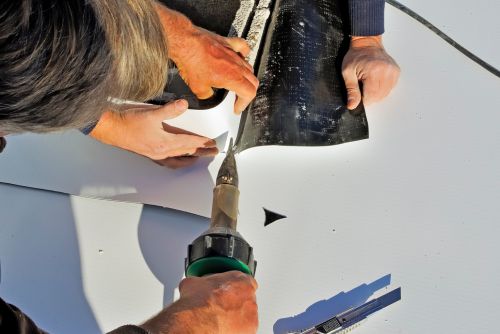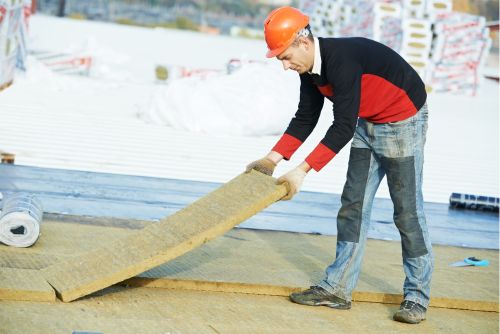
The roofing industry has seen significant advancements in recent years, offering building owners a wide range of options to choose from. One such option is TPO roofing, also known as thermoplastic polyolefin roofing. TPO roofing has gained popularity, especially in commercial buildings, due to its energy efficiency, durability, and affordability. However, like any other roofing material, TPO roofing also has its disadvantages. In this blog, we will explore the cons of TPO roofing, helping building owners make informed decisions when considering this roofing option.
Before delving into the disadvantages of TPO roofing, it is important to have a clear understanding of what it is. TPO roofing is a type of roofing system that consists of a thermoplastic polyolefin membrane. This roofing material is noted for its energy efficiency, durability, and UV resistance, making it an attractive choice for flat commercial roofs. Now, let us take a closer look at the composition and popularity of TPO roofs.
TPO roofing membranes are composed of a thermoplastic polyolefin polymer base, which is specifically designed to withstand the sun’s harsh UV rays. This composition ensures the longevity of TPO roofs, as they can resist solar loads and remain UV resistant. The white option of TPO roofing is particularly energy efficient, as it reflects ultraviolet light and reduces heat absorption, resulting in reduced cooling costs. Additionally, TPO roofing manufacturers often provide a warranty, guaranteeing the quality and reliability of their membranes.
TPO roofing has gained popularity, especially in the commercial roofing sector. Commercial buildings often have flat roofs, and TPO roofing systems offer numerous advantages for such structures. The energy efficiency of TPO membranes, along with their resistance to high heat, makes them an appealing option for building owners seeking eco-friendly roofing solutions. Furthermore, TPO roofs provide excellent protection against costly commercial roof repair NJ, as they are resistant to seam failures and leaks. The professional installation of TPO roofing by experienced roofing contractors further contributes to their popularity and optimal performance.
Before diving into the disadvantages, it is important to note the significant advantages of TPO roofing. This roofing material is praised for its energy efficiency, durability, and affordability. Let us explore these pros in more detail.
Energy efficiency is one of the key advantages of TPO roofing. The thermoplastic polyolefin membranes effectively reflect UV rays, reducing heat absorption into the building. This results in lower cooling costs, contributing to energy savings and environmental friendliness. TPO roofing materials are designed to withstand solar loads, maintaining their integrity and durability over time. Additionally, their UV resistance helps to prolong the lifespan of the roof, further enhancing their energy efficiency. The energy efficiency of TPO roofing makes it a cost-effective choice for building owners, as it can lead to long-term energy savings.
Durability is another significant advantage of TPO roofing. These membranes are known for their high heat resistance, making them suitable for diverse climates. They can withstand extreme temperatures, ensuring the roof’s longevity and durability. TPO roofing materials are also highly resistant to mold, mildew, and punctures, which contributes to their durability. Unlike rubber roofing, TPO membranes offer enhanced durability and are less prone to cracking, shrinking, or deteriorating due to exposure to high heat. This durability factor reduces the frequency of commercial roof replacements NJ, making TPO roofing a cost-effective long-term option for building owners.
Affordability is a significant advantage of TPO roofing. Compared to other roofing options, TPO roofing is relatively cost-effective, especially when considering its long-term benefits. The lightweight nature of TPO membranes reduces installation time, labor costs, and material expenses, making it an affordable choice for commercial buildings. Additionally, TPO roofing offers excellent insulation, which can lead to energy cost savings in the long run. Their minimal maintenance requirements further contribute to their affordability, as building owners can save on long-term ownership costs. The combination of durability, energy efficiency, and affordability makes TPO roofing an attractive option for many commercial buildings.

While TPO roofing has numerous advantages, it is essential to consider its disadvantages before making a decision. In this section, we will explore the cons of TPO roofing, including quality variations, vulnerability to punctures, and the risks of improper installation.
One of the disadvantages of TPO roofing is the potential for quality variations in the membranes. Different manufacturers may produce membranes of varying quality, which can affect durability and performance. Inconsistent material thickness can impact the overall integrity of TPO roofing membranes, potentially leading to premature failures. It is crucial for building owners to select reliable TPO products from reputable manufacturers to mitigate these quality variations. Consulting commercial roofing contractor NJ, experienced in TPO roofing installations, can provide guidance on selecting high-quality membranes and ensuring optimal performance.
TPO roofing membranes, while durable, can be vulnerable to punctures and tears, especially in high traffic areas or during installation and maintenance activities. Some of the key factors contributing to their vulnerability include:
Improper installation of TPO roofing can result in significant drawbacks, affecting performance, longevity, and warranty coverage. Some of the risks associated with improper installation include:

Determining whether TPO roofing is worth the investment requires a thorough assessment of its cost-benefit ratio. In this section, we will explore the factors that influence the value of TPO roofing, including energy savings, manufacturer’s warranty, and regional considerations.
When considering TPO roofing, building owners should evaluate the cost-benefit ratio, taking into account factors such as energy savings and warranty coverage. Some key considerations include:
When determining the value of TPO roofing, it is crucial to consider weather and regional factors. TPO roofing membranes are engineered to withstand varying climates, but regional considerations can impact their performance. Some key factors to evaluate include:

The lifespan of TPO roofing is an important aspect to consider when assessing its feasibility. In this section, we will explore the factors that can influence the longevity of TPO roofing, including maintenance and installation quality.
Regular maintenance plays a crucial role in extending the lifespan of TPO roofing. Some key impacts of maintenance on the longevity of TPO roofs include:
The quality of TPO roofing installation plays a significant role in its lifespan, energy efficiency, and overall performance. Some key points regarding installation quality include:

Installing TPO roofing requires professional expertise to ensure its durability, energy efficiency, and longevity. In this section, we will highlight the importance of professional installation and selecting the right contractor.
Professional installation of TPO roofing is critical for several reasons:
Choosing the right contractor for TPO roofing installation is vital for a successful project. Consider the following when selecting a contractor:
There are several myths and misconceptions surrounding TPO roofing. In this section, we will debunk some of these myths and provide accurate information about TPO roofing:
Myth 1: TPO roofing is similar to rubber roofing or EPDM.
Fact: While rubber roofing, including EPDM, is indeed a popular option, TPO roofing is distinct from rubber roofing materials. TPO roofing offers enhanced durability, resistance to high heat, and longevity compared to rubber roofing options.
Myth 2: TPO roofing is not as durable as other roofing materials, such as PVC.
Fact: TPO roofing materials provide durability and longevity, rivaling other roofing options such as PVC. TPO membranes have high resistance to mold, punctures, and chemical exposure, ensuring long-term performance.
Myth 3: TPO roofing has significant seam failures and leaks.
Fact: Properly installed TPO roofing systems, with reliable seams, seldom experience failures or leaks. Adhering to manufacturer guidelines and engaging professional installers significantly reduces the risk of seam failures.
Myth 4: TPO roofing is prone to punctures, tears, and mold growth.
Fact: While TPO roofing membranes can be vulnerable to punctures, tears, and mold, proper installation and maintenance minimize these risks. Regular inspections, prompt repairs, and proactive maintenance help mitigate potential issues, ensuring the roof’s durability.
Myth 5: TPO roofing is not a cost-effective option for commercial buildings.
Fact: On the contrary, TPO roofing is known for its affordability and cost-effectiveness, especially for commercial buildings. Its lightweight nature reduces installation time, labor costs, and material expenses, providing long-term value for building owners.
By debunking these common myths, building owners can make informed decisions regarding the suitability of TPO roofing for their commercial buildings.
While TPO roofing offers numerous advantages, building owners may consider alternative roofing options to meet their specific needs. In this section, we will explore some of the alternatives to TPO roofing:
In conclusion, TPO roofing has its advantages and disadvantages that need to be carefully considered before making a decision. While it offers energy efficiency, durability, and affordability, there are also concerns about quality variations, vulnerability to punctures and tears, and the risks of improper installation. It is important to assess the cost-benefit ratio and consider regional factors when deciding if TPO roofing is worth the investment. Additionally, proper installation by a professional contractor is crucial for maximizing the lifespan of TPO roofs. It is also essential to debunk common myths and explore alternative roofing options to make an informed choice. Ultimately, thorough research and consultation with experts will help you make the best decision for your roofing needs.